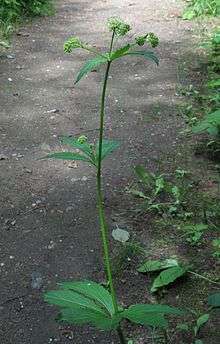Sanicula marilandica
| Maryland black snakeroot | |
|---|---|
 | |
| Scientific classification | |
| Kingdom: | Plantae |
| (unranked): | Angiosperms |
| (unranked): | Eudicots |
| (unranked): | Asterids |
| Order: | Apiales |
| Family: | Apiaceae |
| Genus: | Sanicula |
| Species: | S. marilandica |
| Binomial name | |
| Sanicula marilandica L. | |
Sanicula marilandica, the Maryland sanicle[1] or Maryland black snakeroot, is a flowering plant widespread in North America but rare along the Pacific coast of the continent and Texas. Sanicula marilandica is listed as Sensitive in Washington state.
Leaves with deeply incised lobes radiating out from the same point. Every leaf has no set number of leaflets, but commonly will have 5–7. The plant is not tall but the fruiting stalk will rise up to 2 feet, bearing green diminutive flowers in spring. In fall the fruiting stalk carries dehiscent fruit that splits, bearing small spines.
References
- ↑ "Sanicula marilandica". Natural Resources Conservation Service PLANTS Database. USDA. Retrieved 30 October 2015.
This article is issued from Wikipedia - version of the 3/15/2016. The text is available under the Creative Commons Attribution/Share Alike but additional terms may apply for the media files.